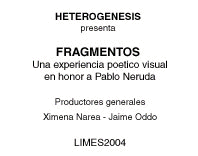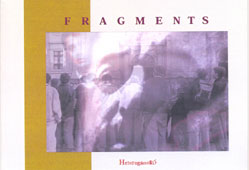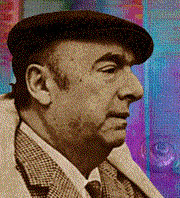|
Essentiality in the poetry of Pablo
Neruda
by JORGE
OLIVERA
(Translation: Jorge
Capelán)
|
Image,
word and poetry have always been linked to the oral character of language,
and it is for that reason that ”poetry was the first of the arts;
poetry, language and the preservation of myth grew up together”1.
Poetry is one way of showing the hidden realms of the world, a particular
form of the image about that world which the poet constructs with language,
and then projects onto the written or spoken word. I want to highlight
that presence of the spoken word over the written word in order to understand
the sonority of the poetic language and its manifestation through the
image. The way in which that language constructs its images to reach the
reader or listener; material sound of language which constructs the image
that poetry finally delivers. This takes place because the written texts
are, in one way or another, related to the sound, ”natural ambience
of the language in order to transmit its meanings”2.
In
Neruda, one can perceive the intention of ”wanting to rescue a
word that can be an immediate blossoming of interiority (…) implies
a suspension of the reflexive consciousness, a state of rapture, of
alienation [which leads him to abandon] the analytical thought for the
analogical, which has its own causality”3. The poetic language
constructs the image, which transmits the sound already present in the
essence of the former. Sound and image represent the two sides that
make poetry, and in the case of the Chilean poet allow him to construct
that essentiality of his poetry. The idea of ”conceiving poems
as if they were direct manifestations of the natural energy”4,
a place where the poet transforms himself into the axis from where the
world can be contemplated: ”I am a poet, the one most lost in thought
on the contemplation of the earth; I wanted to break, with my little
jumbled poetry, the fence of mystery that surrounds the crystal, the
wood and the stone, I specialized my heart in listening to the sounds
that the universe unleashed in the oceanic night, in the silent extensions
of the earth or the air…”5.
This
stance of Neruda shows us a way of constructing the poem that has been
called a ”mythical-metaphoric poetic”6 – a place where
the image meets the desire to constitute itself into a speaker for an
us, the rescue of the community’s memory. In this sense, the oral
character of language always has had a close relationship with poetry,
since it was centered around the ways of articulation of the knowledge
of the community and the preservation of its memory. In this process,
the oral character of language has needed of poetry in order to communicate
that memory, and it had done so through the creative metaphoric construction
of images. Actually, ”writing can never do without the oral (…)
reading a text means translating it into sounds”7 and these sounds
are the basic constituents of the poetic image.
”The
metaphor is probably the most fertile power owned by man”, sustained
Ortega y Gasset8. I cannot come up with another way of thinking the
poetic work of Pablo Neruda but through the image as a way of conveying
the feeling and the construction of a fertile space of communication
with the reader. ”The metaphor hides an object by supplanting it
for another, and it wouldn’t make any sense if we couldn’t
see beneath it an instinct that induces man to elude realities”
adds the Spanish philosopher. In Neruda, that phenomenon of supplanting
has as its ultimate end the unveiling of reality, it is one of the axis
of his work, because in it “poetry is essentially discovery and
expression of the vital rhythm”9. I underline three relevant aspects,
the metaphor as a useful tool, the capacity to achieve the supplanting
it possesses and the sonorous expression of that vital rhythm generated
in it.
We
could say that the metaphor in Neruda is “the use of material images
in order to suggest immaterial relations”, a “delicate substance
of language (…) constructed on the foundations of metaphor”10;
a modality seeking poetic images to interpret the voice of a people,
an expression from the deepest feelings of the group. Thus, he can say
“Poverty was for Spain / like horses of smoke, / like stones fallen
from / the springs of misfortune…” (from España en
el Corazón)11, actually establishing the conjunction between
the tackling of the verse and the metaphor that transforms the material
into immaterial. This is a way of working with the written word that
evokes the propitiatory oral character of the poetic, a presentation
of a world of images constructed by the sound. The poet assumes himself
as the one who names: “Nothing have I discovered / everything already
was / when I passed through this world, / if I return to this place
/ I beg the discoverers / to keep some things for me, / an unnamed volcano
/ an unknown madrigal.” (Artes Poéticas, II)12, the giver
of voice to the surrounding space.
We
can then observe that “the nature-revealing metaphor is the very
substance of poetry. The known interprets the dark, the universe lives
the myth. The perceptible world’s beauty and freedom provide a
model, and life is impregnated with art” 13; and that the poet
becomes “the channel for the dark forces of the Genesis”14,
a re-generator of the myth and the memory.
This
is a way of constructing a perception and a conception of the world
that results in an aesthetics suited for the wide public, that which
a critic called “closer to the blood than to the ink”, together
with the “sensation that Neruda’s poetry gives of tearing
down canons and intellectualisms in order to exclusively exalt or spin
the fibers of the human”15.
All
of Neruda’s poetry, from the romantic to the social, is marked
by that attachment to the word and the image that emerge spontaneously
and are its generating source. Let us recall how in Walking Around16
that duality of the social and the individual is already present, “it
happens that I get tired of being a man. / It happens that I go to tailor
shops and cinemas / I wither, impenetrable, like a felt swan / navigating
waters of origins and ashes / or putting a nun to death by a blow in
the ear” and the existential image that reconciles him with the
world: “I don’t want to go on being a root in the dark”.
Neruda’s
poetry evocates images because it has as a basic precondition its attachment
to the world, its direct relationship with its circumstance, right in
the place where language is converted into metaphor without obscuring
what has been said, but shedding light on the verse. The analogical
procedure in Neruda is the prime material that allows us to evoke his
poetry as a succession of images transiting the verse. Thus, the image
evokes the creational myth before it transforms itself into a game of
language. It is the image what refers us to that condition of the oral:
the sound – an almost prophetic dimension of his poetry which emerges
like a rushing stream full of metaphors and sets the poet on the place
of its very primal condition, the place where image, word and poetry
construct the memory of the collectivity17. The essentiality of poetry
lies in its condition of sound become image – an evocative form
of the human, which is the modality of expression of Neruda’s poetry.
That is also the reason of its profound hold on the readers, a poet
to whom all those who look for their roots always return to.
Footnotes
1
Fenollosa, Ernest – Pound, Ezra, El carácter de la escritura
china como medio poético, Visor Libros, Madrid, 2001, p. 52
2 Ong, Walter, Oralidad y Escritura. Tecnologías de la palabra,
FCE, Buenos Aires, 1993, p. 7
3 Yurkevich, Saúl, Fundadores de la Nueva Poesía Latinoamericana,
Barral Editores, Barcelona, 1973, p. 163.
4 Ibid, O. Cit. p. 165
5 Words of Pablo Neruda at the International Congress of Democracies,
Montevideo, 1939, quoted by Rodríguez Monegal, Emir, El vajero
inmóvil. Introducción a Pablo Neruda, Losada, Buenos Aires,
1966, p. 101
6 Yukevich, Saúl, Op. Cit. p. 224
7 Ong,Walter, Op. Cit. p. 17
8 Ortega y Gasset, La desumanización del arte, Revista Occidente,
Madrid, 1923, p.
9 Portuondo, José Antonio, Concepto de la poesía, El Colegio
de México, 1945, p. 150
10 Fenollosa – Pound, Op. Cit. p. 50
11 Nerida, Pablo, Tercera Residencia, Seix Barrals, Barcelona, 1990,
p. 41. The translation of these verses was made by Jorge Capelán
12 Neruda, Pablo, Fin de Mundo, Losada, Buenos Aires, 1970, p. 79. The
translation of these verses was made by Jorge Capelán
13 Fenollosa – Pound, Op. Cit, p. 51
14 Turkevich, Saúl, Op. Cit. 177
15 De Lellis, Mario J., Pablo Neruda, Editorial la Mandrágora,
Buenos Aires, 1957, p. 9.
16 Neruda, Pablo, Residencia en la Tierra, Losada, Buenos Aires, 1974,
p. 85-86 The translation of these verses was made by Jorge Capelán
17 “In Neruda, as in Bréton, a mythological behavior takes
place. Both seek the naturalization of the artistic language, the abolition
of the pre-established modules, as if they wanted to level the grounds
of the established and the institutionalized”, in Yurkevich, Saúl,
Op. Cit. p. 176
|





